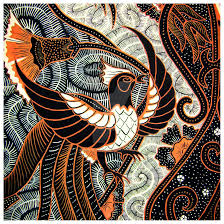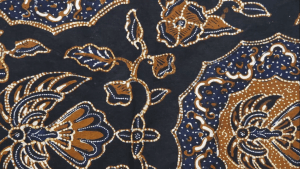Ancient Batik Art
Batik art is a technique of making cloth by applying wax-resist dyeing. It is an ancient art form which uses wax and dyes to create a visual magic on fabrics. These techniques was originated in Indonesia. It is believed that the term ‘batik’ has been derived from the word `Ambatik’ stands for a piece of cloth with small dots or writing with wax or drawing in broken lines.
It is an art form which is appreciated all over the world. In October 2009, UNESCO designated Indonesian batik as a “Masterpiece of Oral and Intangible Heritage of Humanity”. In Batik painting, the artist uses wax to prevent dye from penetrating the cloth which results in “blank” areas in the dyed fabric.
The process can be repeated over and over to create complex multicolored designs. Batik art is done with many types of dye & wax on cotton, silk and many other natural fabrics.
Indian Scenario Of Batikart
No one knows the perfect reason for how batik arrived in India although there are various theories about its place and period of origin. Indians are known to use Batik method of printing designs on cotton fabrics for more than 2000 years.
Traditionally, the Khatri community of Gujarat is believed to perform these art form from ancient times. In ancient times, wax and even rice starch were used for printing on fabrics. Previously batik was made only for dresses and tailored garments,
but in the modern times, batik art is applied to numerous items, such as wall hangings, paintings, household linen, and scarves, with livelier and brighter patterns. To encourage this art form, this art is made as a course in some of the deaf and mute schools of India. It is also taught to rural women through various vocational programs.

International Scenario of Batik Art
Batik originally came from Indonesia and as it spread to different parts of the world, different designs of Batik evolved according to the region where it was developed.
Today, it is practiced in a large part of the world and different country has evolved their own form of Batik Painting. Countries apart from India, where Batik printing is done even today, are –
a) Indonesia
Indonesia, where these art form originated is the most popular country even today for its Batik art. Most of the Indonesian batik patterns are symbolic. Various designs of Batik are connected to good luck, some of the designs are ceremonial i.e. which designs will be worn in the specific ceremonies such as birth, marriage or death.
Some designs of Batik are reserved for royalties and common people are not allowed to wear that designs of Batik. Batik has evolved as the cultural identity of Indonesia. Clothes of these prints have a great significance in the life of the Indonesian peoples.

b) Sundan
Sundanese Batik is the art form practiced in the Priangan region of West Java. Although Batik clothes designed in Sundan are made in various colors, a preference of Blue color or Indigo is seen in the Batik art of these regions.

c) Sumatra – Trade relations between the Sumatran empire and Javanese coastal region was the reason for the development of the Sumatran form of Batik painting. These art form got popular in the Jambi town of the Sumatra. In 1875, A man named Haji Mahibat revived the declining Batik industries of Jambi.

d) Balinese Batik
The Batik art also influenced some part of the islands of Bali where it became a usual part of the dressings of the common people. Here the clothes of the Batik art are not limited just to few ceremonies or functions but are also wore as daily wears.

e) Sri Lanka
Sri Lankan Batik industry is small scale industry that mainly produces Batik painting and art materials for foreign customers. Batik here is seen as a commercial item, unlike in other South Asian island countries where it acts as a representative of their cultural identity. Mahawewa region of Sri Lanka is famous for Batik industry.
 f) China
f) China
Batik art in China is usually done by the ethnic people of South-West China. People belonging to the Miao, Bouyei and Gejia tribes are engaged in making traditional costumes made be Batik painting. Batik art form has traditional importance in China. Like Indonesia, even the Chinese Batik paintings have symbolism.
g) Africa
it is said that the modern African Batik form was brought be the Dutch peoples in Africa during colonial times. But, shreds of evidence suggest that this art form was practiced by Africans even before the colonial times, but that art form was different than the Indonesian Batik Art.
Dutch brought these form to Africa where a new form of Batik art was heartily accepted and today in most part of the African Continent, Batik designed clothes are worn as their symbol of culture.

Making Of Batik Art
- STEP A) – Drawing the Pattern

- STEP B) – Applying the wax

- STEP – C) Dying the fabric

- STEP D) – Keeping the fabric to be dried

- STEP E) – Removal of Wax

- STEP F) – Reapplying of Wax

- STEP G) – The finished Batik

Present Day Scenario of batik art
In ancient times these art form was done on only on cotton and silk, but in recent times, other fabrics like Georgette is also being used. The most famous place of India for this art is Cholamandalam near Chennai, Tamil Nadu.
Today, Batik printing is also practiced in the various states of India such as Gujarat, Rajasthan, Andhra Pradesh, Maharashtra, West Bengal and Madhya Pradesh. These painting has evolved with time and today it is very famous in Cloth Industry.
After the 1980s, these art form got popularized in various parts of India and housewives and small scale entrepreneurs started making Batik designs and in very less time it became a famous market product.
In Indian markets, Batik sarees are generally priced around Rs. 1000/- to Rs. 1500/- for Cotton sarees and for Silk sarees, the prices ranges between Rs. 4000/- to Rs. 10000/-.
Conclusion of Ancient Batik Art
Looking at the amazing scenario of Batik art form and its acceptance worldwide, we can say it’s not a simple art it’s a representation of the culture of many countries. Batik have both cultural and traditional importance but its commercial importance can’t be forgotten.
It forms the base for a lot of small scale industries all over Asian and African continent. In India, Batik Sarees are one of the most loved forms of Saree. So, completely if we look at these art form, then we can say at least one thing for sure that this is more than just an art form.
It forms economic lifelines of millions of people, cultural representation of many countries and a loved dressing design all over the world. At last, Batik can be referred to as an art form which developed in South East Asia but now is loved and heartily accepted by the Whole World.



